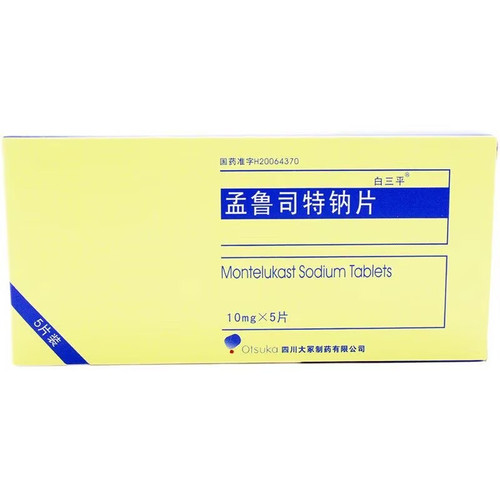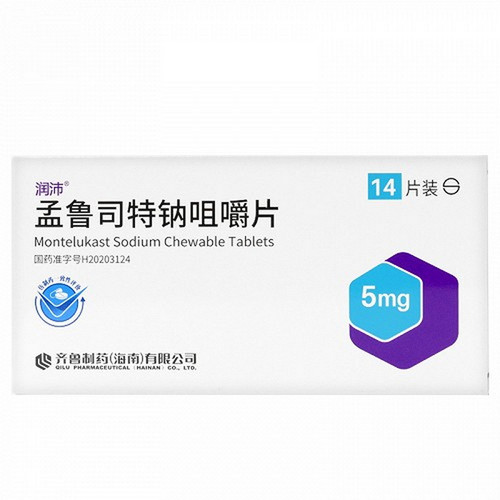Product Overview
[Drug Name]
Generic Name: Montelukast Sodium Chewable Tablets
Trade Name: Bai San Ping Montelukast Sodium Chewable Tablets 5mg*14 Tablets
Pinyin Full Code: Bai San Ping Meng Lu Si Te Na Ju Jiao Pian 5mg*14 Tablets
[Main Ingredient]
The main ingredient of this product is montelukast sodium.
[Appearance]
This product is a white tablet.
[Indications/Main Functions]
For the prevention and long-term treatment of asthma in adults and children aged 2 years and older, including prevention of daytime and nighttime asthma symptoms, treatment of aspirin-sensitive asthma, and prevention of exercise-induced bronchoconstriction. This product is suitable for children aged 2 years and older and adults to relieve symptoms of seasonal allergic rhinitis.
[Specifications]
5mg*5 tablets (Bai San Ping)
[Dosage and Administration]
Once daily. Asthma patients should take the tablet at bedtime. Seasonal allergic rhinitis patients can take the tablet at a later time based on their individual needs. Patients with both asthma and seasonal allergic rhinitis should take the medication once nightly. (See package insert for details.)
[Adverse Reactions]
This product is generally well tolerated. Adverse reactions are mild and generally do not require discontinuation of treatment. The overall incidence of adverse reactions with this product is similar to that with placebo. This product has been evaluated in clinical studies in approximately 2,600 adult patients with asthma aged 15 years and older. In two similarly designed, placebo-controlled, 12-week clinical trials, abdominal pain and headache were reported at a higher rate than placebo in the 1% of patients treated with this product and were considered drug-related adverse events. However, the incidence of these adverse events did not differ significantly between the two groups. In clinical studies, a total of 544 patients have been treated with this product for at least 6 months, 253 patients for 1 year, and 21 patients for 2 years. The incidence of adverse events did not change with longer treatment duration with this product. The safety profile of this product has been evaluated in 2,199 adult patients aged 15 years and older with seasonal allergic rhinitis. This product, taken once daily in the morning or evening, was well tolerated, with an adverse reaction rate similar to that of placebo. In placebo-controlled clinical studies, the incidence of adverse events in the treatment group was less than 1%, and the incidence of somnolence was similar to that of the placebo group across all clinical studies. The use of this product in pediatric asthma patients has been evaluated in approximately 320 pediatric patients aged 6 and 14 years. Overall, the safety profile of this product in pediatric patients was similar to that of adults and similar to that of placebo. In an 8-week placebo-controlled clinical trial, the only drug-related adverse event, occurring at a higher rate (1%) in the treatment group compared to the placebo group, was headache. However, the incidence of headache did not differ significantly between the two treatment groups. A total of 143 pediatric patients aged 6 to 14 years have been treated with this product for at least 3 months, and 44 patients have been treated for 6 months or longer. The adverse event profile did not change with longer treatment duration with this drug. This drug was evaluated in approximately 573 pediatric patients aged 2 to 5 years with asthma. In a 12-week, placebo-controlled clinical trial, the only drug-related adverse event reported at a higher rate of 1% in the pediatric group compared with the placebo group was thirst. However, the incidence of thirst did not differ significantly between the two groups. A total of 426 pediatric patients aged 2 to 5 years have been treated with this drug for at least 3 months, 230 patients for 6 months or longer, and 63 patients for 12 months or longer. The adverse event profile did not change with longer treatment duration with this drug. The safety profile of this drug was evaluated in 280 pediatric patients aged 2 to 14 years with seasonal allergic rhinitis in a 2-week, placebo-controlled clinical trial. The safety profile of this drug, taken once daily in the evening, was similar to that of the placebo group. In this study, the incidence of adverse reactions in the treatment group was less than 1%, and no drug-related adverse reactions were found. The incidence was higher than that in the placebo group. Postmarketing Experience: The following adverse reactions have been reported with postmarketing use of this product: hypersensitivity reactions (including anaphylaxis, angioedema, rash, pruritus, urticaria, and rarely, eosinophilic infiltration of the liver); abnormal dreams and hallucinations; somnolence; excitement; irritability, including aggressive behavior; restlessness; insomnia; paresthesias; tactile disturbances; and, more rarely, seizures; nausea, vomiting, dyspepsia, diarrhea; elevated ALT and AST; and, rarely, cholestatic hepatitis; arthralgias, including myalgia with muscle cramps; increased bleeding tendency; bruising; palpitations; and edema.
[Contraindications]
This product is contraindicated in patients with hypersensitivity to any of the ingredients.
[Drug Interactions]
This product can be used in combination with other medications commonly used for the prevention and long-term treatment of asthma and the treatment of seasonal allergic rhinitis. In drug interaction studies, the recommended dose of this product did not produce clinically significant pharmacokinetic effects on the following drugs: theophylline, prednisone, prednisolone, oral contraceptives (ethinyl estradiol/norethindrone 35/1), terfenadine, digoxin, and warfarin. The area under the plasma concentration-time curve (AUC) of montelukast decreased by approximately 40% in patients taking concomitant phenobarbital. However, no dose adjustment of this product is recommended.
[Precautions]
The efficacy of this product for the treatment of acute asthma exacerbations has not been established. Therefore, it should not be used to treat acute asthma exacerbations. Although the dose of concomitant inhaled corticosteroids can be gradually reduced under the guidance of a physician, this product should not be used abruptly to replace inhaled or oral corticosteroids. Rarely, patients receiving antiasthma medications, including leukotriene receptor antagonists, have experienced one or more of the following when their systemic corticosteroid doses were reduced: eosinophilia, vascular rash, worsening pulmonary symptoms, cardiac complications, and/or neuropathy (sometimes diagnosed as Churg-Strauss syndrome, a systemic eosinophilic vasculitis). Although a causal relationship to leukotriene receptor antagonists has not been established for these conditions, caution and appropriate clinical monitoring are recommended when reducing the systemic corticosteroid dose in patients receiving this medication.
[Pediatric Use]
Safety and efficacy studies have been conducted in children aged 6 months to 14 years. Safety and efficacy in children under 6 months of age have not been studied.
[Geriatric Use]
In clinical studies, there were no age-related differences in the efficacy and safety of this medication.
[Pharmacology and Toxicology]
Cysteinyl leukotrienes (LTC4, LTD4, LTE4) are potent inflammatory mediators released by a variety of cells, including mast cells and eosinophils. These important pro-asthma mediators bind to cysteinyl leukotriene (CysLT) receptors. Type I cysteinyl leukotriene (CysLT1) receptors are located throughout the human airways (including airway smooth muscle cells and airway macrophages) and other pro-inflammatory cells (including eosinophils and certain bone marrow stem cells). CysLTs are implicated in the pathophysiology of asthma and allergic rhinitis. In asthma, leukotriene-mediated effects include a range of airway responses, such as bronchoconstriction, mucus secretion, increased vascular permeability, and eosinophil accumulation. In allergic rhinitis, CysLTs are released from the nasal mucosa during both the immediate and delayed phases following allergen exposure, contributing to the symptoms of allergic rhinitis. Intranasal CysLT provocation increases nasal airway resistance and symptoms of nasal obstruction. This product is a potent oral formulation that significantly improves inflammatory markers in asthma. Biochemical and pharmacological assays have demonstrated that montelukast has a high affinity and selectivity for the CysLT1 receptor (compared to other pharmacologically important airway receptors such as prostanoid, cholinergic, and beta-adrenergic receptors). Montelukast effectively inhibits the physiological effects of LTC4, LTD4, and LTE4 binding to the CysLT1 receptor without any receptor agonist activity. Current research suggests that montelukast does not antagonize the CysLT2 receptor.








